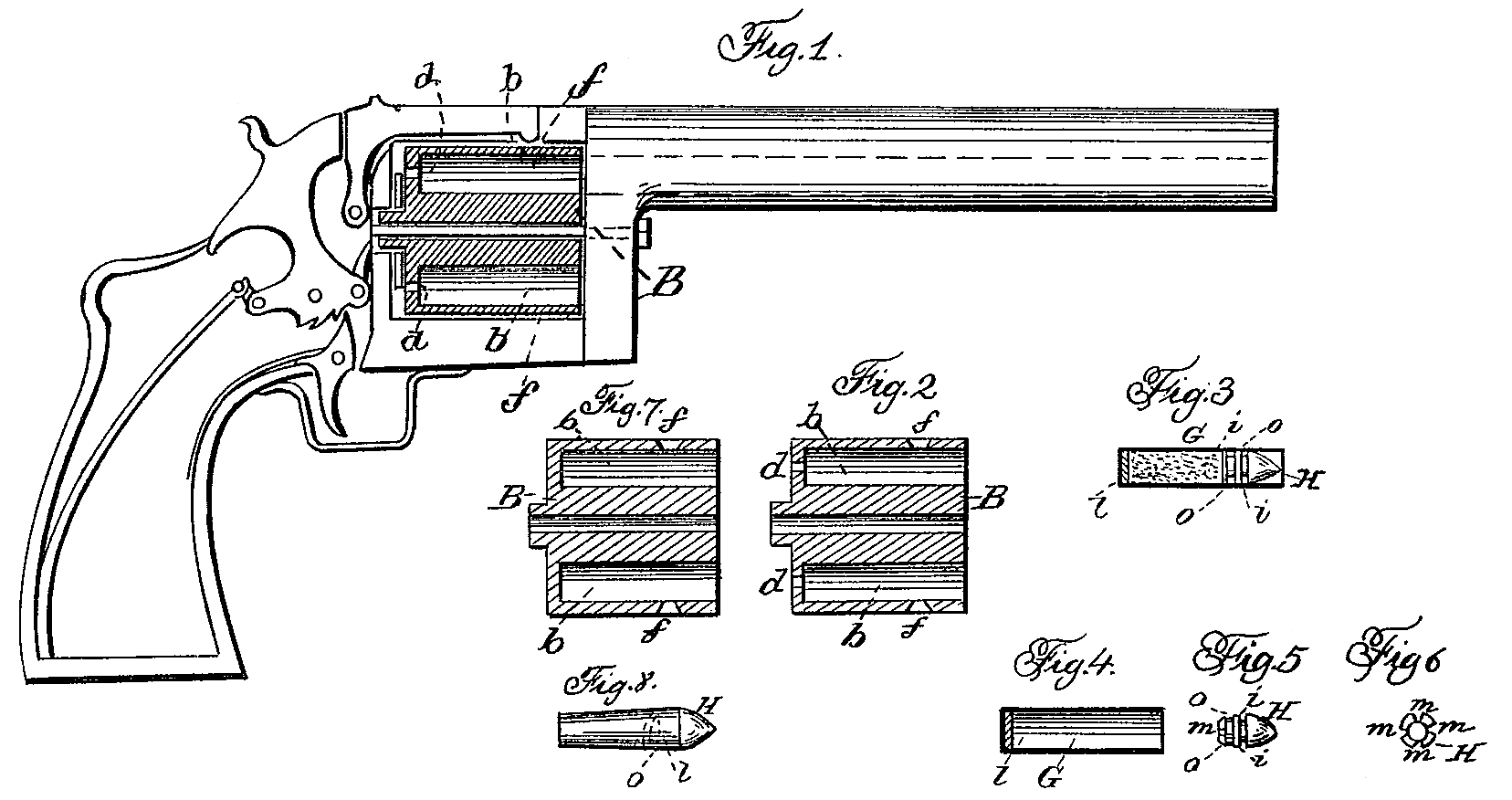US 41803
UNITED STATES PATENT OFFICE.
S. W. WOOD, OF CORNWALL, NEW YORK.
IMPROVEMENT IN REVOLVING FIRE-ARMS.
Specification forming part of Letters Patent No. 41,803, dated March 1, 1864.
To all whom it may concern:
Be it known that I, S. W. Wood, of Cornwall, in the county of Orange and State of New York, have invented a new and Improved Fire-Arm; and I do hereby declare that the following is a full and exact description thereof, reference being had to the accompanying drawings, making part of this, specification—
Figure 1 being a side view of a pistol provided with my improvements, the revolving cylinder being in section; Fig. 2, a central longitudinal section of the cylinder; Fig. 3, a central longitudinal section of an improved cartridge adapted to this arm; Fig. 4, a central longitudinal section of the cartridge-case; Fig. 5, a side view of the bullet used in the cartridge; Fig. 6, an end view of the bullet, showing the notches communicating with the powder in the rear of the bullet; Fig. 7, a central longitudinal section of a cylinder entirely closed at its rear end, adapted to receiving a cartridge with a non-metallic case; Fig. 8, a non-metallic-case cartridge carrying its own fulminate, to be used in my improved cylinder.
Like letters indicate corresponding parts in all the figures.
I employ an improved revolving cylinder, B, for the purpose of using metallic or nonmetallic case cartridges containing their own fulminate, and to be loaded into the front end of the cylinder. The chambers b b do not extend through the cylinder, but may have small apertures d d extending from their rear ends back through the cylinder, (see Fig. 2,) to allow the insertion of a small rod for expelling the empty cartridge-cases after being discharged. When non-metallic cartridges are used the rear end of the cylinder will be closed, as in Fig. 7. In the sides of the cylinder, nearer to the front than to the rear end thereof, or in a proper position for the purpose intended, as hereinafter set forth, is a set of apertures, f f, opening respectively into the chamber bb of the cylinder. These apertures admit the point of a hammer or an intermediate hammer-dog into the chambers, so as to strike upon the sides of the cartridge-cases and make a suitable indentation therein to explode the fulminate. The case of the cartridge G, to be used in connection with this improved cylinder, preferably, though not necessarily, extends the whole length of the chamber and of the simple form of the chamber. It has no fulminate in its rear end; but the bullet H has an annular groove, i, near its rear end, substantially as shown, in which the fulminate o is placed. From this groove small notches or openings in lead back into the powder-chamber behind, so as to communicate the fire of the fulminate freely to the powder. The fulminate groove i in the ball is so situated in the cartridge-case and the cartridge is so arranged in the chamber of the cylinder that the end or front of the hammer stall strike the cartridge-case directly over the fulminate and thereby explode it. Thus all flanges for receiving the fulminate are dispensed with, and the whole construction of both cylinder and cartridge is reduced to its utmost simplicity.
There may be a strengthening-disk, l, placed in the bottom or rear end of the cartridge-case, to guard against the force of the explosion blowing through the case into the aperture d at the rear end of the cylinder.
What I claim as my invention, and desire to secure by Letters Patent, is—
The employment of apertures in the periphery of the cylinder, in front of the bottom of its chambers, leading respectively into the same, so as to admit the hammer to strike against the sides of the primed cartridges and explode them, substantially as described.
S. W. WOOD.
Witnesses:
J. S. Brown,
P. E. Wilson.

